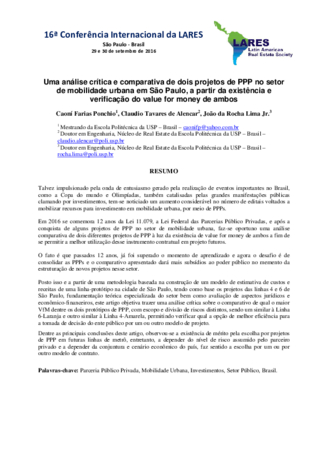Talvez impulsionado pela onda de entusiasmo gerado pela realização de eventos importantes no Brasil, como a Copa do mundo e Olimpíadas, também catalisadas pelas grandes manifestações públicas clamando por investimentos, tem-se noticiado um aumento considerável no número de editais voltados a mobilizar recursos para investimento em mobilidade urbana, por meio de PPPs.
Em 2016 se comemora 12 anos da Lei 11.079, a Lei Federal das Parcerias Público Privadas, e após a conquista de alguns projetos de PPP no setor de mobilidade urbana, faz-se oportuno uma análise comparativa de dois diferentes projetos de PPP à luz da existência de value for money de ambos a fim de se permitir a melhor utilização desse instrumento contratual em projeto futuros.
Posto isso e a partir de uma metodologia baseada na construção de um modelo de estimativa de custos e receitas de uma linha-protótipo na cidade de São Paulo, tendo como base os projetos das linhas 4 e 6 de São Paulo, fundamentação teórica especializada do setor bem como avaliação de aspectos jurídicos e econômico-financeiros, este artigo objetiva trazer uma análise crítica sobre o comparativo de qual o maior VfM dentre os dois protótipos de PPP, com escopo e divisão de riscos distintos, sendo um similar à Linha 6-Laranja e outro similar à Linha 4-Amarela, permitindo verificar qual a opção de melhor eficiência para a tomada de decisão do ente público por um ou outro modelo de projeto.
O fato é que passados 12 anos, já foi superado o momento de aprendizado e agora o desafio é de consolidar as PPPs e o comparativo apresentado dará mais subsídios ao poder público no memento da estruturação de novos projetos nesse setor.
Dentre as principais conclusões deste artigo, observou-se a existência de mérito pela escolha por projetos de PPP em futuras linhas de metrô, entretanto, a depender do nível de risco assumido pelo parceiro privado e a depender da conjuntura e cenário econômico do país, faz sentido a escolha por um ou por outro modelo de contrato.
Maybe driven by the wave of enthusiasm generated by the completion of important events in Brazil such as World Cup and Olympics, also catalyzed by large public demonstrations calling for investments, it has reported a considerable increase in the number of targeted announcements to mobilize resources for investment in urban mobility through PPPs.
In 2016 it celebrates 12 years of Law 11,079, the Federal Law of Public Private Partnerships and after the conquests of some PPP projects in the urban mobility sector, it is desirable a comparative analysis of two different PPP projects in the light of existence of value for money of both in order to allow the best use of this contractual instrument in future projects.
The fact is that after 12 years, has already surpassed the teachable moment and now the challenge is to consolidate the PPP and the comparative presented here will give more support to the government in the moment of structuring new projects in this sector.
That said and from a methodology based on the construction of a costs and revenues estimation model from a line-prototype in the city of São Paulo, based also on the designs of lines 4 and 6 São Paulo, specialized theoretical basis of the sector as well as assessment of legal, economic and financial aspects, this article aims to bring a critical analysis over the comparison of which the greatest VfM among the two PPP prototypes, with different scopes and risks allocation, being one similar to Line 6-Orange and another similar to Line 4-Yellow, allowing to be checked which option is the best in terms of efficiency for the decision-making of the public entity.
Among the main conclusions of this article, there was the existence of merit by the choice of PPP projects in future subway lines, however, depending on the level of risk assumed by the private partner and depending on the situation and the country's economic scenario, makes sense the choice of one or other contract template.
